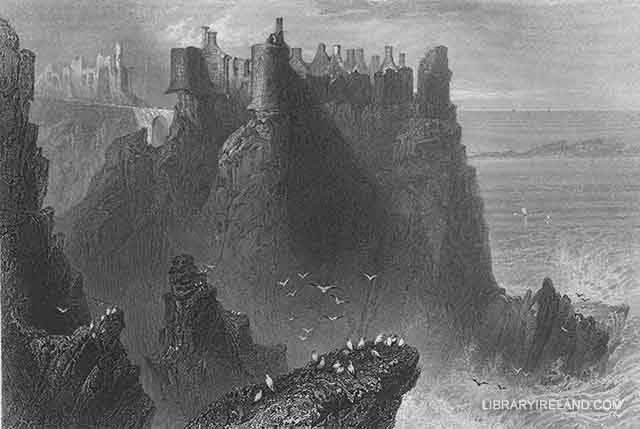Dunluce Castle, County Antrim
A VISIT to the Causeway is rather a leg-weary business, and admiration is well known to travellers to be the most effective of tonics. On emerging from the cave and climbing the cliff once more, we were not sorry to find our carman ready to take us to Bushmills, a mile distant, where we found a most excellent inn, and breakfasted on salmon, very much to the refreshment of our enthusiasm. The day was bright and summery, and in high good spirits we mounted our car towards noon, and took our way to DUNLUCE CASTLE.
It was but a mile or two from Bushmills, and, before we were well settled in our seats, this finest of ruined castles broke upon us, like an apparition, in the road. Dunluce stands on a perpendicular and insulated rock, the entire surface of which is so completely occupied by the edifice that the external walls are in continuation with the perpendicular sides of the rock. The walls of the building were never very lofty, but from the great area which they enclosed, contained a considerable number of apartments. One small vaulted room is said to be inhabited by a banshee, whose chief occupation is sweeping the floor.
This story originates in the fact that the floor is at all times as clean as if it had just been swept; but this mystery can be explained without the introduction of Maw Roi, the fairy, by the fact that the wind gains admittance through an aperture on a level with the floor, and thus preserves the appearance of cleanliness and freedom from dust just now mentioned. In the north-eastern end is a small room, actually projecting over the sea, the rocky base having fallen away; and from the door of this apartment there is a giddy view of the sea beneath. The rock on which the castle stands is not surrounded by water, but is united at the bottom of the chasm to the mainland by a ledge of rock a little higher than the surface of the ocean. The castle was entered by a bridge formed in the following manner:—two parallel walls, about eight feet asunder, thrown across the chasm, connected the rock with the mainland. Upon these planks were laid crosswise for the admission of visitors, and removed immediately after the passage was effected. At present but one of the walls remains, about thirteen inches in thickness; and the only pathway to the castle is along its summit, over the awful rocky chasm. The distance at which the other parallel wall was placed, may be perceived by the traces of its connection with the opposite rock.
On the mainland, close to the castle, a second collection of similar buildings are seen, erected at a later period by one of the Antrim family, in consequence of the giving way of an apartment on the verge of the rock. Beneath the cliff on which the rock stands is a cave, penetrating completely through from the sea to the rocky basin on the land-side of the castle. It may be entered by a small aperture in the south end, and at low-water there is a good deal of the flooring uncovered, which consists of large round stones; which have attained this form from the action of the waves. The sides and roof are of basalt, possessing merely the usual characters; here also is a very remarkable echo when the surface of the water is unruffled.

